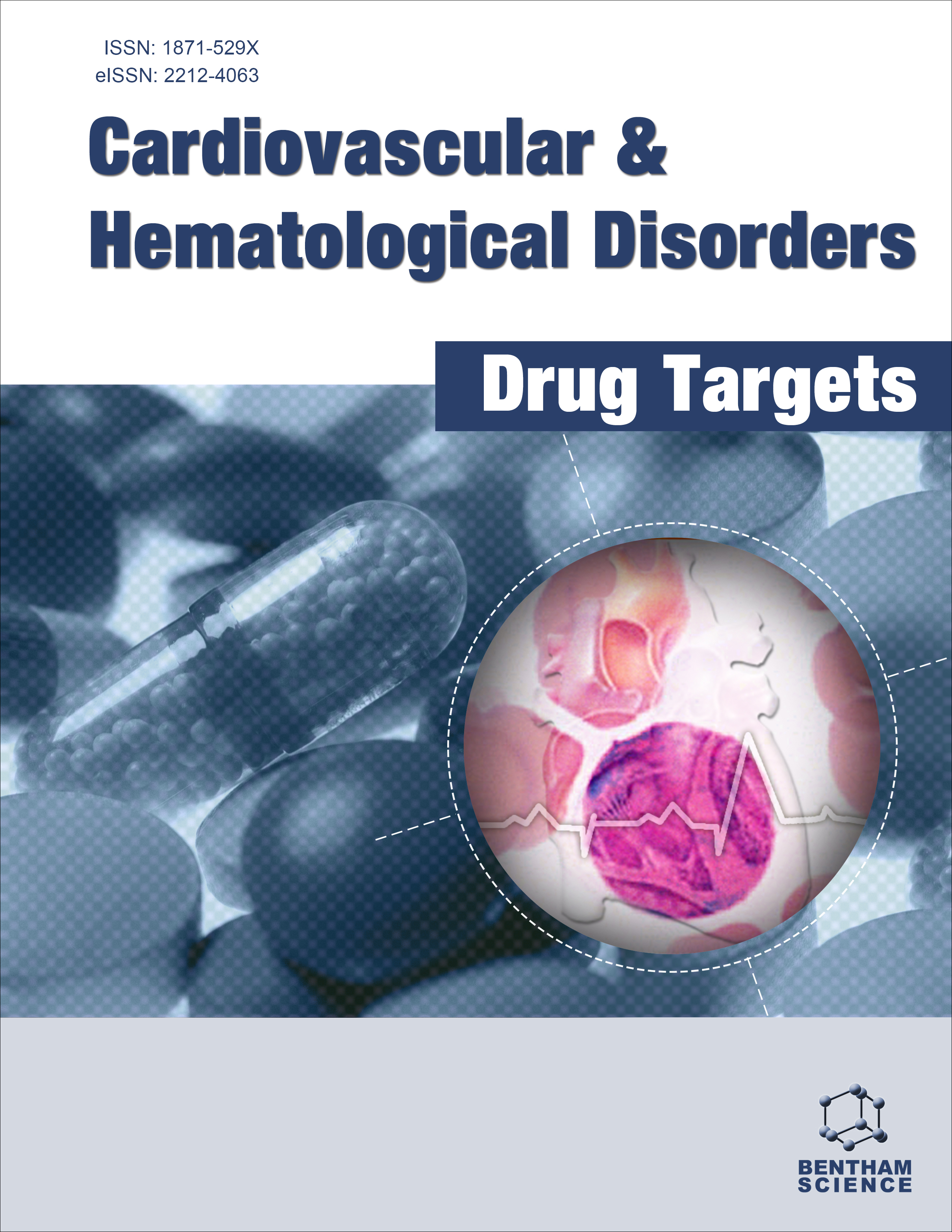- Home
- A-Z Publications
- Cardiovascular & Haematological Disorders - Drug Targets
- Previous Issues
- Volume 16, Issue 1, 2016
Cardiovascular & Haematological Disorders - Drug Targets - Volume 16, Issue 1, 2016
Volume 16, Issue 1, 2016
-
-
Multiple Drugs Causing Severe Anemia in Infective Endocarditis
More LessAuthors: Ajit Singh, Prasad N. Shetty, Brij Mohan Kumar Singh and Tom DevasiaCeftriaxone and linezolid are commonly used antibiotics in infective endocarditis. Here we present a rare case of severe anemia caused by both the drugs via different mechanisms. Drugs have shown significant contribution in inducing anemia via hemolysis and bone marrow suppression in an infective endocarditis patient.
-
-
-
Ischemic Strokes in Congenital Bleeding Disorders: Comparison with Myocardial Infarction and other Acute Coronary Syndromes
More LessAuthors: Girolami Antonio, Ferrari Silvia, Cosi Elisabetta, Peroni Edoardo and Girolami BrunoObjective: To investigate the occurrence of ischemic stroke in patients with congenital bleeding disorders. Patients and Methods: Patients with congenital bleeding disorders who presented an objectively proven ischemic stroke were obtained by means of a time unlimited Pubmed search. Appropriate key words and Medical subject headings were used. Cross-checking of the references was also carried out. Results: There w Read More
-
-
-
Antioxidants in the Practice of Medicine; What Should the Clinician Know?
More LessAuthors: Thomas F. Whayne, Sibu P. Saha and Debabrata MukherjeeAntioxidants offer protection against the damage potentially caused by free radicals, which usually involve an oxygen or nitrogen moiety, in living organisms. An antioxidant can be defined as a molecule that has the capability to inhibit the oxidation of another molecule, so, in other words, it is a reducing agent that is sufficiently stable to donate an electron to a circulating free radical and thereby result in its neutralization. Free Read More
-
-
-
Articular Bleeding in Hemophilia
More LessHematologic primary prohylaxis is the gold standard of treatment in persons with hemophilia (PWH). The goal is to reduce or prevent joint bleeds and subsequent joint degeneration (hemophilic arthropathy). In acute hemarthroses, early treatment with factor (VIII or IX) replacement and rest of the joint (4 to 5 days) are paramount. In patients with inhibitors (antibodies against factor VIII or IX) we can use bypassing agents suc Read More
-
-
-
Idarucizumab: Clinical Role of a Novel Reversal Agent for Dabigatran
More LessAuthors: Mohamed Teleb, Kevin Salire, Miraie Wardi, Haider Alkhateeb, Sarmad Said and Debabrata MukherjeeAtrial fibrillation (AF), a common cardiac arrhythmia associated with increased risk of heart failure, thromboembolic phenomena and death, is a leading cause of hospitalization of adults. A major complication of AF is an increased risk of ischemic stroke leading to long-term disability and in severe cases, death. Historically, Coumadin has been the drug of choice for chronic anticoagulation and stroke prevention in AF patients Read More
-
-
-
Antidotal Effects of Curcumin Against Agents-Induced Cardiovascular Toxicity
More LessAuthors: Tahereh Farkhondeh and Saeed SamarghandianCurcumin, the major phenolic compound in turmeric, shows preventive effects in various diseases. Curcumin is commonly found in rhizome of the Curcuma species and traditionally used in herbal medicine. Numeros studies has indicated that curcumin posses protective effects against toxic agents in various systems including cardiovascular. This study found that curcumin may be effective in cardiovascular diseases induced Read More
-
-
-
The Effect of Stevia on the Chicken Embryo Heart
More LessAuthors: Parisa Sadighara, Isa Mohammadpour, Mahdi Jahanbakhsh, Atefeh Araghi and Ahmad NazaktabarBackground: Stevioside is one of the most important food additives that has become well known for its sweetness. The aim of this study was to evaluate the impact of Stevioside on the heart. Methods: 4-day-old embryonated chickens eggs were inoculated with Stevioside and kept until hatching. Shortly after, the heart tissue samples were taken to examine organ Oxidative stresses by measuring Malondialdehyde (MDA) Read More
-
-
-
The Effects of Zataria Multiflora on Blood Glucose, Lipid Profile and Oxidative Stress Parameters in Adult Mice During Exposure to Bisphenol A
More LessAuthors: Saeed Samarghandian, Mohsen Azimini-Nezhad and Tahereh FarkhondehBackground: The present study evaluated the effects of Zataria multiflora (Z. multiflora) ethanolic extract on the hyperglycemia induced by bisphenol A (BPA). Method: In the present research, mice were randomly selected into the following categories of 6 mice in each group: group one, control (C); group two, in which mice received 0.5 mg/kg of BPA, group three, in which mice received 2 mg/kg of BPA, group four, which Read More
-
-
-
Cardiovascular effect of Nigella sativa L. Aqueous Extract in Normal Rats
More LessAuthors: Morad Hebi, Naoufel Zeggwagh, Lhoussaine Hajj, Bachir El Bouhali and Mohamed EddouksThis study aims to evaluate the cardiovascular effect of Nigella sativa L. aqueous extract (NSAE) in normal rats. The in vivo experiment showed that the intravenous injection of NSAE at the doses of 50, 100 and 200 mg/kg of body weight produced a dose dependent reduction in the mean arterial blood pressure (MABP) (p<0.001) accompanied by a significant fall in heart rate (p<0.01). In the in vitro experiment, incubation of NSAE Read More
-
Volumes & issues
-
Volume 24 (2024)
-
Volume 23 (2023)
-
Volume 22 (2022)
-
Volume 21 (2021)
-
Volume 20 (2020)
-
Volume 19 (2019)
-
Volume 18 (2018)
-
Volume 17 (2017)
-
Volume 16 (2016)
-
Volume 15 (2015)
-
Volume 14 (2014)
-
Volume 13 (2013)
-
Volume 12 (2012)
-
Volume 11 (2011)
-
Volume 10 (2010)
-
Volume 9 (2009)
-
Volume 8 (2008)
-
Volume 7 (2007)
-
Volume 6 (2006)
Most Read This Month
Article
content/journals/chddt
Journal
10
5
false
en


